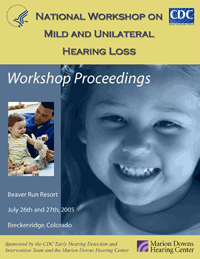 |
|
Early Hearing Detection & Intervention (EHDI) Program |
 |
|
EHDI > Mild and Unilateral Hearing Loss |
 |
Mild and Unilateral Hearing Loss
|
 |
National Workshop on Mild and Unilateral
Hearing Loss (2005)
 CDC
EHDI and the Marion Downs Hearing Center cosponsored the National
Workshop on Mild and Unilateral Hearing Loss on July 26 and 27,
2005. The main goal of the workshop was to review and discuss
current information related to the identification and appropriate
intervention for children with mild and unilateral hearing loss. CDC
EHDI and the Marion Downs Hearing Center cosponsored the National
Workshop on Mild and Unilateral Hearing Loss on July 26 and 27,
2005. The main goal of the workshop was to review and discuss
current information related to the identification and appropriate
intervention for children with mild and unilateral hearing loss.
The first part of the workshop consisted of three sessions: (1)
Prevalence and Screening; (2) Diagnosis, Amplification, and
Outcomes; and (3) Early Intervention, Eligibility, and Clinical
Practice. Each of these sessions included presentations by
researchers and clinicians that highlighted key issues.
During the second part of the workshop, participants joined one of
the four following breakout groups to discuss a list of topics that
related to issues associated with mild and unilateral hearing loss
in children.
Group 1: Screening for Hearing Loss
Group 2: Diagnostic Evaluation and Follow-up
Group 3: Hearing Technology
Group 4: Early Intervention
During the third and final part of the workshop the facilitator of
each breakout group presented a summary to all participants about
what was discussed in their respective groups.
Please click here to view the
agenda
(PDF).
More information about this workshop can be found in the
Proceedings
(PDF).
Mild and Unilateral Hearing Loss:
Summaries of Research Articles
Danielle S. Ross, PhD, MSc
and W. June Holstrum, PhD
These tables summarize scientific and review articles on mild and
unilateral hearing loss in children. The list of references for
these tables is not meant to be exhaustive, but instead focuses on
specific topics, such as prevalence, outcomes (e.g., speech,
language, and auditory perception), parental concerns, psychosocial
aspects, and possible interventions (e.g., amplification and
classroom assistance).
NOT included in these summary tables are articles on otitis media
(i.e., the focus is on permanent hearing loss), articles on adults
with acquired hearing loss, articles published before 1980, articles
focusing exclusively on etiology, and articles focusing on outdated
technology.
This series of tables will be updated on an ongoing basis, with
several articles planned to be added in the near future.
These summary tables are provided for information purposes only. The
contents of the summaries are derived solely from the research
articles themselves and do not necessarily represent the views of
the Centers for Disease Controls and Prevention.
Acknowledgements: The following individuals helped in summarizing
these articles: W. June Holstrum, Benjamin Rodriguez, Denise Green,
Vickie R. Thompson, Marcus Gaffney, and Jamie Elliott. I would also
like to thank the librarians and Pamela Mason at the American
Speech-Language-Hearing Association (ASHA) for their help in
identifying the additional articles that will soon be added to this
series of summary tables.
Please
click here for the reference list of all the articles included
in these tables (updated 1/29/2008).
Table List
[Return to top]
Date:
April 04, 2008
Content source: National Center on Birth Defects and Developmental
Disabilities
|
 |
|